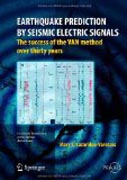
Earthquake prediction by seismic electric signals: the success of the VAN method over thirty years
Lazaridou-Varotsos, Mary S.
This book deals with the presentation of the widely known earthquake prediction method, termed VAN method. This method constitutes nowadays the only earthquake prediction effort that has led to concrete successful results. It is based on the detection of low frequency electric signals termed Seismic Electric Signals (SES) - by measuring voltage point-to point differences on the Earth’s surface using electrodes embedded in the ground- that precede earthquakes witha lead time usually from several hours to a few months. The book presents first the theoretical model - based on solid state physics aspects- that motivated this research effort (Chapter 2), and then explains in simple words the SES physical properties along with their explanation (Chapter 3). All the documentation of the international evaluations of the VAN method over the years, including those carried out by International Conferences held in Greece (in 1984 and 1990) and in USA (in 1992 and 1995), as well as by a United Nations Conference in Japan in 1994 and by an International Meeting of experts at the Royal Society of London in 1995, is presented in Chapters 4, 8, 10, 11 and 12. Further, the book describes, step by step, all the developments of the VAN method since 1981. This includes the facts that preceded all the major earthquakes in Greece during the last 25 years, i.e., since 1986 when the installation of the VAN telemetric network has been completed and the SES properties have been identified. Presents advances in the fields of earthquake prediction over the last three decades. Highlights the VAN method. Provides an analysis with modern techniques in statistical physics INDICE: 1. Earthquakes, seismology. the van earthquake prediction method. 2. How the van research on earthquakes prediction started. 3. The procedure for the measurements. the telemetric van network and how we predict the epicenter and magnitude. 4. First international evaluation of van in 1984. 5. The powerful earthquakes of 1986. 6. The disastrous earthquakes in killini-vartholomio(w. greece) in 1988. Public warning issued by haroun tazieff. 7.The french interest on van (1986-1989). The book of haroun tazieff (1989) and the interruption of the van network (1989). - 8. Second international evaluation of van in 1990. Conference supported by onassis foundation. -9. The disastrous earhquakes in pirgos (w. greece) in 1993: the public warning. 10.Third evaluation of van: the international conference at california (lake arrowhead) in 1992 and itsfollow-up at berkeley in 1995. 11. The united nations recommendation on van in 1994 and the preceding earthquakes. 12. Van evaluation by the royal society of london in 1995 and by the american geophysical union in 1996. 13. The 6.0 earthquake at chalkidiki (n. greece) in 1995. The government verifies the success of prediction. 14.The 6.6 earthquake at grevena-kozani (n. greece) in 1995.-15.The disastrous 6.5 earthquake at erateini-egion (central greece) on 15 june 1995. 16. The international prize of onassis foundation in 1995. 17. The disastrous 5.9 athens earthquake in 1999. 18. Proposal for a new concept of time and its applications. natural time. 19. The 6.5 earthquake in northern sea in 2001. 20. Why and how we changed the way to publicize the predictions since 2006. 21. The 6.9 earthquake at southwestern greece on february 14, 2008. It wasthe largest during the last 28 years. The public warning. 22. The disastrous 6.5 earthquake between patras and pirgos (w. greece) on 8 june 2008. The public warning. 23. Current views on the van earthquake prediction method in other countries.
- ISBN: 978-3-642-24405-6
- Editorial: Springer Berlin Heidelberg
- Encuadernacion: Cartoné
- Páginas: 400
- Fecha Publicación: 16/02/2012
- Nº Volúmenes: 1
- Idioma: Inglés
